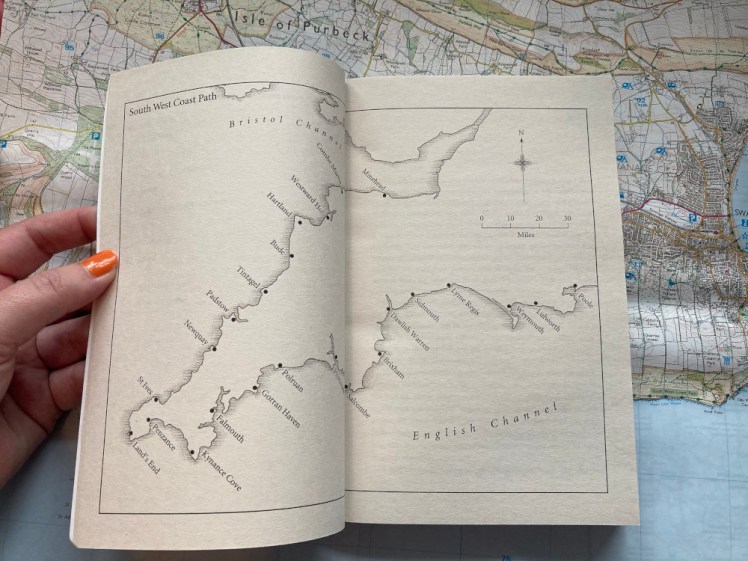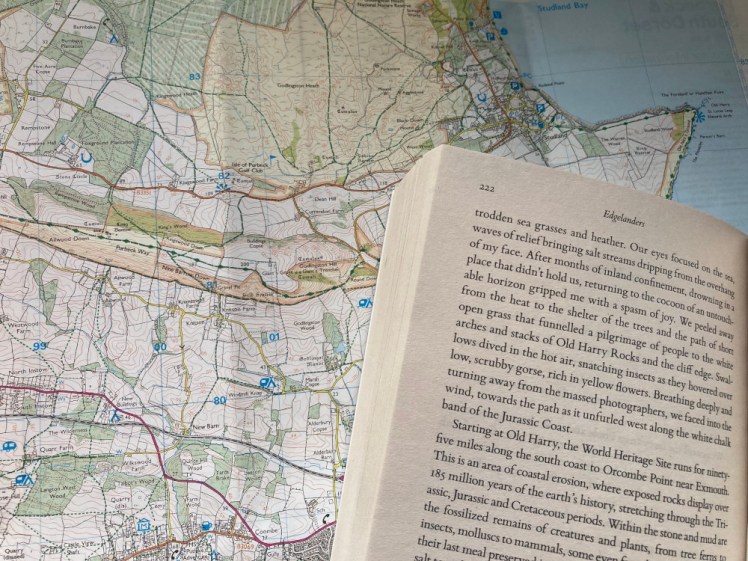Now, this is a book of two halves, because for the first few chapters, I was shaking my head and going “Yet again, I’m going to have to write on my blog that I read a travel-themed book that I didn’t particularly like”. But it got better. This month’s book is also the Rebel Readers’ book club book and it’s The Salt Path by Raynor Winn, which is the story of how the double whammy of her home and business being repossessed and a terminal diagnosis for her husband led to the pair of them walking the South West Coast Path.

The first few chapters are about said repossession. They invested in a friend’s business and somehow ended up being responsible for its debts when it failed, which resulted in three years of legal action which ended in their home being repossessed. As the home was a farm and a B&B, that also meant their jobs became non-existent overnight. I felt like there’s a certain amount of playing the victim in these chapters – Raynor finds some evidence at the eleventh hour which proves they’re not responsible but after three years, manages to miss the fact that there’s a correct legal procedure to follow with this, which means it gets thrown straight out, and the paragraphs of “… because we didn’t know” really come across as “we are small naive children who the system is being nasty to even though we’re so naive and delightful”. Of course it’s not fair, of course it’s a hideous thing to happen but had it not had that tone of childish naivety, I would have sympathised a lot more.
Almost the very next day, husband Moth is diagnosed with incurable corticobasal degeneration, CBD. It’s a rare degenerative condition where the brain is damage by build-up of tau proteins. Tau occurs naturally in every brain but in people with CBD, it doesn’t break down like it should and forms clumps. Now, there’s no actual test for CBD, it’s a case of ruling out any other possibilities and this being all that’s left and there’s no treatment for it, other than medication to ease the symptoms. I don’t want to give away massive spoilers here but Moth’s symptoms improve rapidly over their long walk and according to Raynor’s Instagram, he does appear to be alive and well today. According to the doctor in the book, during the summer of 2013, CBD sufferers live around 6-8 years after the onset of symptoms. It apparently takes the best part of 6 years to get the diagnosis in the first place and that was now more than eleven years ago. I haven’t read the two follow-up books to The Salt Path, which presumably continue Ray & Moth’s story but the fact that he’s still going strong seventeen years later really makes me wonder if CBD is an accurate diagnosis. But there, I’m not a doctor, I’d never heard of it before I picked up this book and I’ve never met Moth Winn.
Becoming suddenly homeless and with potentially very limited time left to spend with Moth, Ray decides they’re going to walk the South West Coast Path. Why not? They’ve got nothing better to do and nowhere to go. A job would mean spending precious time away from Moth and with only a couple of hundred pounds in the bank and a repossession hanging over them, they can’t afford a new home and won’t be high priority for council housing. Ray reflects a lot on homelessness as they walk the path – on the way people are physically repulsed when they find out they’re not just backpacking the Path but doing so because they’re homeless – but she really makes a point of differentiating between people like themselves, who have merely been horribly unlucky and people with problems like addictions, who she almost seems to imply deserve homelessness for it being their own fault. Almost. There really is a “we’re not like them” flowing through this book.

So they set off with the smallest cheapest tents and sleeping bags they can get their hands on, a guidebook which forces them to begin from Minehead even though it would be physically easier for them to begin at Poole and go off with virtually no preparation or idea what they’re doing. This book has been made into a film, which is on general release next April, and I can already see the hilarious scene required in every film of this kind, where they struggle to put up the tent for the first time with no idea what they’re doing. They wild camp their way from Somerset to Dorset and they do get better at it as they go along. Wild camping is technically illegal in England – give or take the debacle on Dartmoor – but if no one catches you, you can get away with it. At the beginning, they pretty much pitch on the path and leave a certain amount of chaos behind them but by the end, they’re pitching on a golf course and getting away with it under the very nose of the owner/groundskeeper simply by packing the tent up early, doing it all so very neatly and claiming “we’re just here to watch the sunrise”. Barely a blade of grass is disturbed; the man can’t actually point to any evidence that they’ve been here all night. Leave no trace at its finest.
They live mostly off noodles and bits and pieces from supermarkets, with the occasional treat in coastal cafes and tea shops that they really can’t afford – one major mistake made early on is failing to cancel the insurance on the home they no longer own, meaning that a sum of money they were expecting to be available on a particular day just isn’t. They regularly run out of water – getting bottles refilled for free is apparently harder than I realised, with many cafes refusing to give them tap water when they should be buying a bottle of water, and a lot fewer public taps and fountains than I thought existed in the touristy south-west.
The positives: the further on they go, the more Moth’s symptoms vanish. Far from being unable to get out of the tent by himself, one night when the tent is pitched on the beach with the tide coming in, he jumps up and lifts the tent, contents and all and sprints further inland like Hercules. When they spend the window living in a friend’s converted shed, the symptoms all come rushing back. Whatever the doctor’s advice, it seems repetitive physical exercise with weight on his back is actually doing him good. Ray, who seems to make all the decisions – Moth is a very passive participant in his own life – gets both less bossy and less neurotic as they go on. I read the early chapters, before they actually set off, a couple of weeks ago and then the entire walking part of the book in two sittings on two consecutive nights, so it becomes a lot more readable than it seemed in those first couple of chapters. Push on, it definitely gets better very quickly once they’re underway.
The negatives: the “them vs us” reflections on homelessness, the “it’s better to be homeless than to be living with a terminal illness in a council flat”, the childish naivety at the beginning and the “get a job? Me?”. The fact that this story is so heavily about Moth and yet he almost seems to be more of a featured extra than the driving force behind the walk. I’m not keen on the fact that the dialogue is almost universally untagged, meaning it’s very easy within six sentences to lose track of who is talking about what – is this Ray? Is this Moth? Is this the random person they’ve encountered? Who is saying these things??
I was always under the impression this book was universally adored but when I read the reviews, after just a few chapters, I discovered it’s not, and that a lot of people criticise the writing – calling it “simple” or “naturalistic”, which can be either praise or euphemism for “she’s not very good at writing”. I’m hovering somewhere between the two. It’s certainly not unreadable and the fact that I read 90% of it in two sittings without getting bored says good things. On the other hand, the latter group are perhaps not entirely incorrect.

But as I said, I somehow absolutely devoured this. Once they drop the self-pity and get into the walking, it becomes strangely compelling. You want to keep reading. And at the end, you want to find out what happens next. Well, fortunately, there are two more books. Apparently The Wild Silence deals with the aftermath – their new homes, their new lives, the writing of The Salt Path and then trekking in Iceland (so yes, I’m tempted) and then Landlines follows them on the Cape Wrath trail. I’m probably not tempted enough – I know a lot of people get very invested in the story of Moth in particular. I’m not so much and I don’t think I enjoyed it enough to read the other two but I enjoyed it so much more than I thought I would back at the beginning.
I think we’ve got so used to being able to refill water bottles that we’ve forgotten that it only passed into law in 2017, nearly 4 years after Ray & Moth’s journey began. Prior to that there was absolutely no obligation to do so. I’m old enough that I still feel I want to buy something when I do it, though.
LikeLike